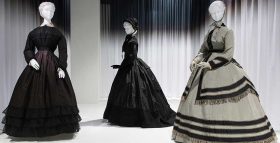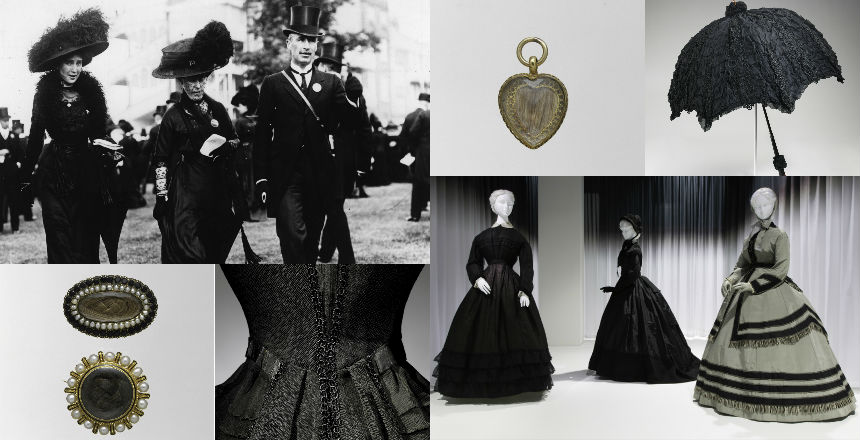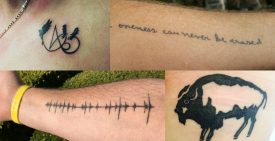I’m no fan of the sexism and classism of 19th- and 20th-century mourning wear, but as a modern-day widow, I can appreciate the function behind the fashion in the Metropolitan Museum’s “Death Becomes Her” exhibit. To society at large, particular fabrics and colors instantly communicated a woman’s state of grief. You wouldn’t know exactly whom she had lost or how, but at a glance you knew if it had happened less than a year ago. Presumably, this information would’ve enabled strangers to interact appropriately with the mourner.
The mourning attire exhibit was fresh in my mind when Modern Loss hosted a screening of an indie feature film called “The Widowers.” Its protagonist, played by Richard Lovejoy, unapologetically wears pajamas — all day, every day — in the majority of his scenes. Now if one of us encountered a stoic, 40-something man clad in old-fashioned, cowboy-and-Indian pajamas at 3 in the afternoon, our first thought wouldn’t be that his wife died in a car crash, but we’d know something in his world was awry.
The pajamas in “The Widowers” function as a brilliant and courageous symbol of outward grief: a flannel signal to the world that no-I’m-not-OK and it’s-best-to-not-to-ask-what-these-flowers-are-for. When you’re in the early stages of grief, interactions with nosy or well-meaning strangers can be incredibly invasive and cruel. Would it not be a public service if the mourner could instantly convey his or her messy mindset without saying a word? If you knew the absent-minded woman who cut the bus line had just lost her daughter/brother/lover, wouldn’t you extend compassion instead of judgment?
While I probably wouldn’t have worn shapeless, flannel PJs in public following any of my losses, I would’ve appreciated the option to wear something that society would recognize as grief garb. And after seeing “The Widowers” and the Met exhibit, my desire to identify or invent a wearable sign of mourning in America is officially reignited.
After researching how other modern cultures and countries use attire or accessories to convey grief, I came up with these parameters: It must be unisex, non-religious, affordable and obvious enough to convey “I’m-in-mourning.” And it should appeal to Millennials through Gen Xers. This item — or ideally, this movement — isn’t about making death trendy or commercialized: It’s about making grief less isolating and more socially acceptable in America.
With these specs in mind, I invited friends within the target demographic who’ve experienced loss into my living room for a brainstorm. Over wine, weed and rice balls, we discussed design riffs on accessories like sunglasses, armbands and hats. We talked about the success of the symbolic red ribbon to signify AIDS and the yellow Live Strong bracelet to indicate cancer. Eventually, the conversation turned toward finding a unique symbol of grief that could be abstracted into an original pattern … and applied to everything from a scarf or an umbrella to a hoodie and lenses of sunglasses.
The possible symbols we came up with? A mourning star, mourning dove, rain or a teardrop. Obviously, a few more living-room brainstorms are needed before the idea is ready for a boardroom or a Kickstarter fund, but I’m a big fan of early crowdsourcing. So I’m inviting you to weigh in, Modern Loss community.
You are the audience for modern mourning wear. You’re the early adopters who can remove the stigma of grief in our society. How do you feel about an abstracted symbol printed on apparel or accessories? Is a mourning star too obscure? A teardrop too cliché? Do you have a different, better idea for a universal grief symbol? Are you a graphic designer who wants to join one of our wine-fueled brainstorms?
Depending on how widely this is shared and what happens in the comments section below, this could become the origin story for the change we wish to see.
Tré Miller Rodríguez is the author of “Splitting the Difference: A Heart-Shaped Memoir” and the popular Tumblr WhiteElephantInTheRoom.com. She is an award-winning copywriter whose essays have appeared in The New York Times, Marie Claire and on MindBodyGreen.com.












